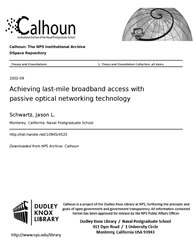File:Achieving last-mile broadband access with passive optical networking technology (IA achievinglastmil109454525).pdf

Original file (1,275 × 1,650 pixels, file size: 2.61 MB, MIME type: application/pdf, 102 pages)
Captions
Captions
Summary[edit]
| Achieving last-mile broadband access with passive optical networking technology
( |
||
|---|---|---|
| Author |
Schwartz, Jason L. |
|
| Title |
Achieving last-mile broadband access with passive optical networking technology |
|
| Publisher |
Monterey, California. Naval Postgraduate School |
|
| Description |
One of the primary challenges in today's computer networking world is providing enough bandwidth to achieve true broadband access in the local, or last-mile, access network. Over the course of the last decade or so, there has been a tremendous increase in the bandwidth of the core network in the U.S. In fact, a substantial portion of this core network, which primarily consists of fiber optic technology, is unused. This is primarily due to the lack of bandwidth in the last-mile access network. The last-mile access network of today primarily consists of technologies (e.g. digital subscriber line and cable modem access) that rely on infrastructures designed to carry voice and cable television signals. As a result, consumers are not able to enjoy true broadband services. This thesis discusses and analyzes the use of passive optical networking (PON) technology as possibly the best solution to today's last-mile bottleneck. General PON technology concepts and details concerning the two primary PON technologies, asynchronous transfer mode (ATM) PONs and Ethernet PONs, are discussed. The application of PON technology in achieving fiber to the home, using both PON-only and PON-hybrid infrastructures, is also described. Finally, the current PON business market and regulatory factors are discussed and analyzed. Subjects: Computer networks; Broadband communication systems |
|
| Language | English | |
| Publication date | September 2002 | |
| Current location |
IA Collections: navalpostgraduateschoollibrary; fedlink |
|
| Accession number |
achievinglastmil109454525 |
|
| Source | ||
| Permission (Reusing this file) |
This publication is a work of the U.S. Government as defined in Title 17, United States Code, Section 101. As such, it is in the public domain, and under the provisions of Title 17, United States Code, Section 105, may not be copyrighted. | |
Licensing[edit]
| Public domainPublic domainfalsefalse |
This work is in the public domain in the United States because it is a work prepared by an officer or employee of the United States Government as part of that person’s official duties under the terms of Title 17, Chapter 1, Section 105 of the US Code.
Note: This only applies to original works of the Federal Government and not to the work of any individual U.S. state, territory, commonwealth, county, municipality, or any other subdivision. This template also does not apply to postage stamp designs published by the United States Postal Service since 1978. (See § 313.6(C)(1) of Compendium of U.S. Copyright Office Practices). It also does not apply to certain US coins; see The US Mint Terms of Use.
|
 | |
| This file has been identified as being free of known restrictions under copyright law, including all related and neighboring rights. | ||
https://creativecommons.org/publicdomain/mark/1.0/PDMCreative Commons Public Domain Mark 1.0falsefalse
File history
Click on a date/time to view the file as it appeared at that time.
| Date/Time | Thumbnail | Dimensions | User | Comment | |
|---|---|---|---|---|---|
| current | 20:52, 13 July 2020 |  | 1,275 × 1,650, 102 pages (2.61 MB) | Fæ (talk | contribs) | FEDLINK - United States Federal Collection achievinglastmil109454525 (User talk:Fæ/IA books#Fork8) (batch 1993-2020 #5129) |
You cannot overwrite this file.
File usage on Commons
The following page uses this file:
Metadata
This file contains additional information such as Exif metadata which may have been added by the digital camera, scanner, or software program used to create or digitize it. If the file has been modified from its original state, some details such as the timestamp may not fully reflect those of the original file. The timestamp is only as accurate as the clock in the camera, and it may be completely wrong.
| Short title | Achieving last-mile broadband access with passive optical networking technology |
|---|---|
| Author | Schwartz, Jason L. |
| Software used | Schwartz, Jason L. |
| Conversion program | Acrobat Distiller 5.0 (Windows) |
| Encrypted | no |
| Page size | 612 x 792 pts (letter) |
| Version of PDF format | 1.4 |

